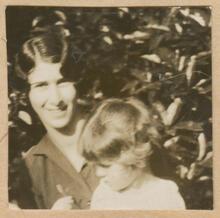Helen Joseph
Called the “grandmother of American puppetry“ for her definitive history of puppets and marionettes, Helen Haiman Joseph was known as a talented designer and director. From 1914 to 1920 she directed Marionette Productions at the Play House. Married in 1918 and widowed in 1919, Joseph published her Book of Marionettes in 1920 and took her two toddlers on a three-year European tour, studying with various marionette workshops. In 1924 she returned to Cleveland and created the Pinocchio Players, writing and producing plays for clubs, schools, and hospitals. She toured the country with her troupe, only stopping when too many of her puppeteers were drafted in World War II. She did odd jobs during the war from factory work to writing advertising copy, then resumed her puppeteering after the war.
An internationally renowned puppeteer and author on marionettes, Helen Haiman Joseph made a career entertaining and educating audiences of all ages with the performance of puppetry.
Early Life and Education
Helen Joseph was born in 1888, in Atlanta, Georgia, to Elias and Frances (Lowenthan) Haiman. Her father’s factory in Georgia produced farm tools and made Confederate swords during the Civil War. The family moved to Cleveland when he became the manager of the Empire Plow Company there. Helen graduated from Cleveland’s Central High School and attended both Vassar College and the College for Women of Western Reserve University (now Case Western Reserve University). She received bachelor’s degrees from both.
After her 1910 graduation, she joined the Cleveland Play House, where she made and manipulated puppets for her first production, “The Death of Tintagiles.” From 1914 to 1920, she directed Marionette Productions at the Play House. In 1918, she married Ernest A. Joseph. He died the next year, leaving her with their daughter Anne and pregnant with daughter Ernestine. Despite the tragedy, Joseph continued with her passion, puppetry.
Career and European Tour
In 1920, her Book of Marionettes, the first definitive history on puppetry written in English, was published. The next year, Joseph took her daughters on a three-year tour through Europe, where her book gained her entry into the most inaccessible marionette studios. In 1924, she returned to the United States, struggled financially, and turned to full-time puppetry as her profession. That same year in Cleveland, she started the Pinnochio Players and, with her staff, wrote and produced puppet plays performed in clubs, schools, and hospitals. “I became a puppet showman in earnest,” she wrote in the Vassar Quarterly (1935) of this time in her life, “writing plays, modeling, carving, painting and dressing the marionettes, selecting and training puppeteers, rehearsing and promoting the plays.”
In the 1930s, Joseph toured the country with her marionette troupe, performing for as many as fifty thousand children a year. She also established a traveling puppet show business, performing shows in factories to express different ideas of management. Her popular puppet engagements at the outdoor playhouse in Cleveland’s Cain Park stopped at the outbreak of World War II because many of her puppeteers and crew were drafted into the military. During the war, she worked in such disparate jobs as writing copy for the Fuller, Smith, and Ross advertising firm and making bullet shells in a factory. After the war, she resumed her marionette performances, still charming audiences with her puppet wizardry.
In addition to A Book of Marionettes, Joseph wrote Ali Baba and Other Plays for Puppets (1927) and Little Mr. Clown (1932), a children’s book based on the marionette Joseph often used in her puppet plays. A series of marionettes sold with the Mr. Clown books were extremely successful in toy stores all over the country. In Cleveland, she served on the boards of the Women’s City Club, the League of Women Voters, and the Consumer’s League.
Legacy
In a 1935 article she wrote for the Vassar Quarterly, Joseph reflected on the satisfactions of puppetry. “It seemed an almost too delicate, too poignant power,” she wrote of the contact with hundreds of children, “playing upon the hearts and imaginations of those great groups of boys and girls, evoking their laughter, their sorrow, their fears, their loyalties by the twitch of a finger inside of a wooden doll.”
Helen Joseph died just two weeks before her ninetieth birthday in August 1978.
Bell, John. American Puppet Modernism. New York: Palgrave Macmillan, 2008.
Bell, John. New York Puppet Modernism:
Dircks, Phyllis T., ed. American Puppetry: Collections, History and Performance. Jefferson, NC: McFarland & Company, 2004.
Joseph, Helen. Clippings file in New York Public Library, Lincoln Center, NYC.
Latshaw, George. The Complete Book of Puppetry. New York: Crafts & Hobbies, 2012.
Puppetry International: Women. No. 16, Fall/Winter 2004.
UJE.
Vassar Quarterly (July 1935).
WWIAJ (1938).










